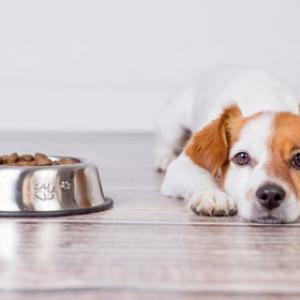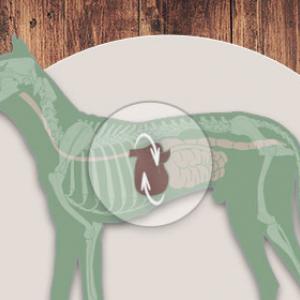Dog food declaration – Don't be fooled!
If you want to buy a high-quality food for your dog, you should not be fooled by pretty pictures and promising advertising, but rather take a look at the declaration. Ideally, all ingredients are listed there so that the composition of the dog food leaves no questions unanswered. We show you what is important!
At first glance, there are many types of food that give an appealing and high-quality impression with images of fresh meat, promising advertising claims and beautifully designed dog food packaging. But a closer look at the declaration quickly reveals that there are often serious differences between the quality-promising dog food packaging and the actual ingredients.
Do you know what’s in dog food?
To answer this question, you need to read the declaration on the back of the packaging very carefully. Because there are numerous tricks here to disguise the ingredients and the quality of the dog food.
By listing the ingredients, a first conclusion can be drawn about the quantitative distribution of the ingredients in the dog food. These are listed in descending order of weight. This means that the ingredient that comes first also makes up the largest proportion in the dog food. However, there is a big difference whether it is an open or closed declaration.
Closed declaration
In the closed declaration, the ingredients are grouped together. Here, the buyer does not receive precise information about the ingredients or the percentage composition of the dog food. Therefore, it can only be roughly determined which ingredients are present in the dog food.
This type of declaration includes the group designation ‘meat’ or ‘meat and animal by-products’. Therefore, only a rough statement can be made about the proportions – the type and quality of the ingredients used remains unclear. The designation ‘meat and animal by-products’ also allows the use of all parts of an animal that result from slaughtering. For example, the dog food may contain predominantly low-quality by-products such as claws, beaks and feathers.
Wheat and other cereals are grouped together under the collective term ‘cereals’. If the group designation ‘grains and vegetable by-products’ can be read on the back, the dog food very likely contains gluten and low-grade flours.
Open declaration
- More cereals than meat
To make a dog food look good, manufacturers usually try to list the meat at the top of the declaration. This should give the buyer the impression that the dog food purchased contains a lot of meat and is therefore a species-appropriate, healthy food for the dog. For this reason, different types of cereals or presentations of the same cereal (e.g. subdivided into ground maize, maize gluten, whey feed flour and wheat flour) are sometimes mixed into a food, each of which is less present than the single meat ingredient. This allows the meat to be listed first, even though there is much more grain in the dog food in total. - Poultry meal or poultry meat meal?
In the declaration, care should be taken to ensure that dried food contains at least ‘poultry meat meal’ or ‘lamb meat meal’ and not, for example, ‘poultry meal’ or ‘lamb meal’. This is because ‘poultry meat meal’ or ‘lamb meat meal’ is made from meat from which the moisture has been removed and which has then been ground into flour. In contrast, ‘poultry meal’ or ‘lamb meal’ is not made exclusively from meat, but mainly from animal by-products, such as claws and beaks. - Animal fats
If only ‘animal fats’ are listed in the ingredients, the manufacturer does not want to disclose which fats were used in the production of the dog food. This can be crucial for a dog with an allergy! Because of this, dog food should clearly declare which animal the fat comes from, such as ‘chicken fat’ or ‘lamb fat’. - How much meat is really in dog food?
When buying dog food, you can get another surprise: if the contents are still described as ‘with delicious chicken’ on the front label, the declaration on the back shows ‘meat and animal by-products (including at least 4% chicken), cereals and vegetable by-products’. In this case, 96% of the ingredients remain hidden and the juicy piece of meat shown is not reflected in the composition. Even the stated proportion of 4% chicken does not indicate whether it is at least high-quality muscle meat or merely low-quality by-products.
If, in addition, the dog food contains 4% chicken, 4% beef and 4% lamb, the manufacturer can even produce 3 different varieties from the same food composition: ‘with chicken’, ‘with beef’ and ‘with lamb’. For all these reasons, it is worth reading the declaration very carefully, because behind the declarations, ingredients can be hidden that are not suitable for a species-appropriate and healthy diet for the dog.

Technical terms explained in more detail
You have more thank likely seen the three terms ‘crude fibre’, ‘crude fat’ and ‘crude ash’ on dog food packaging. We would like to explain these terms to you in more detail in our consultation.
Crude ash
There are two words used here: ‘crude’ and ‘ash’. And indeed, this is about combustion: to determine the crude ash, a sample of the food is heated to 550 °C for 6 hours in a so-called muffle furnace and incinerated in a laboratory. The remaining, non-combustible residue is called crude ash. This consists of minerals (such as the essential bulk and trace elements) and other inorganic substances. Ideally, the crude ash value should be below 10 percent for dry dog food and below 4 percent for wet food.
Many believe that this content should be as low as possible. However, a distinction must be made between inorganic impurities and the important minerals. A low value can be achieved due to low addition of the necessary minerals, and must therefore never be evaluated as a general quality characteristic. A very high value, on the other hand, may indicate impurities.
Crude fibre
Also expressed as a percentage, ‘crude fibre’ refers to the proportion of indigestible vegetable fibre in dog food. For a dog’s diet, such dietary fibres, such as cellulose, are important in limited quantities. These stimulate intestinal activity and shape the faeces.
However, if food has too much crude fibre, it cannot be digested properly, which in turn leads to flatulence and the excretion of large amounts of faeces. Fibre increases the volume of food without being an energy source and increases the time spent in the stomach, so that the rest period after feeding food with a high crude fibre content should be significantly longer.
In addition, the dog must drink enough if it is fed fibre-rich food, as this can bind 100 times its own weight in water.
Crude fat
The crude fat content, which is also given as a percentage, provides information on how energy-rich food is. In addition, fat also provides important essential fatty acids. A good dry food should have a crude fat value of between 6 and 17 per cent, with a minimum value of 5 per cent. For wet food, the values should be between 3 and 11 percent.
However, the mere percentage figure does not have sufficient significance in itself. The quality of fats is determined by the origin and preparation of the raw materials and the absolute and relative content of saturated, monounsaturated and polyunsaturated fatty acids. Unfortunately, this cannot simply be read off the label, but can only be estimated from the list of ingredients and the preparation method.
Product recommendation
The benefits of PLATINUM dog food
- PLATINUM uses a unique preparation method called FSG, which offers numerous advantages compared to conventional dog food.
- Dog food prepared with FSG is gently cooked only in its own meat juice and is therefore nutrient-rich like BARF, excellent for building muscles and also extra tasty for your dog.
- With at least 70% fresh meat in the dry dog food and 83% fresh meat or fresh fish in the wet dog food, PLATINUM places great value on a composition of the food that is adapted to the needs of dogs.
- The declaration and composition of dog food prepared with FSG is tested regularly and independently by ELAB Analytik GmbH (formerly TÜV SÜD ELAB) - for canine health protection.
- PLATINUM is generally very well accepted by dogs of all breeds and ages. Even four-legged friends with sensitive digestion or intolerances usually tolerate PLATINUM dog food well.
- All products are free of soya, GMOs and gluten. In addition, no flavour enhancers, attractants, odourants or colourings are used.
- Over 2,000 positive customer reviews at Trusted Shops speak for themselves!







.png)
.png)
.png)
.png)
.png)